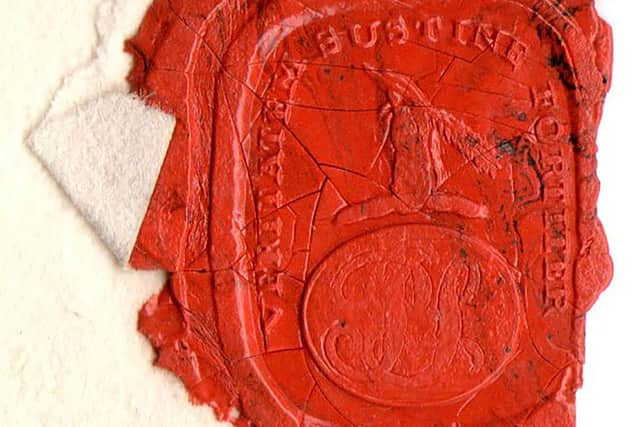The wax mark of the infamous man of the Highland Clearances goes around the world
The seal of Patrick Sellar, factor to 1st Duke of Sutherland and his wife Elizabeth, has been selected as one of the finest objects held by a Highland collection, with it now being used to tell the history of the Highlands and Islands around the world.
Dating to April 1812, the seal is the only known example of its kind to survive, according to Nick Lindsay of Clyne Heritage Society, which runs the Brora Heritage Centre, where it is held.
Advertisement
Hide AdAdvertisement
Hide AdBy the time the seal was made, the Sutherland Clearances were already underway, with it estimated that between 6,000 and 10,000 people from the inner parishes were moved to new crofting settlements on the coast in what has been described as the “most remarkable example of social engineering undertaken in early 19th Century Britain.”


Mr Lindsay said the seal appeared on a letter written to a solicitor regarding the practice of muirburn – the burning of heath and stubble on a moor – on one of the estate farms and is now one of the key items in a digitised collection of items from six Highland museums.
Mr Lindsay said: “I’ve seen plenty of Sellar’s letters but I am not aware of any other examples of his seal that exist.
“It is an impression of his signet ring that he has stamped on the hot wax and the letter is written in his hand, in his little scribbly writing
"We put the item forward for the collection given Sellar was the henchman directing operations on the grounds during the Clearances. He was the archetypal bad figure of the Clearances and is a very important name in the history of Sutherland.”
In 1814, the clearance of tenants in the parish of Strathnaver to make way for sheep farming led to the deaths of Donald McBeath, an old man in extremely poor health, and Margaret McKay, who was 90 years old and still in her home when it was set alight. Sellar was later charged with their culpable homicide and wilful fireraising.
The case went to trial at the High Court in Inverness in April 1816, where a jury made up of landowers, businessmen and lawyers found the factor not guilty.
Mr Lindsay said: “He got off scot-free. None of the witnesses could speak English, nothing was conducted in Gaelic, the jury were all landed gentry and couldn’t understand Gaelic so it was all stacked against the people and stacked in his favour. The establishment basically got him off.”
Advertisement
Hide AdAdvertisement
Hide AdFollowing his acquittal, Sellar ceased to be the factor to the Duke of Sutherland but continued to grow his business as a successful sheep farmer. The letter, fixed with the wax stamp, was sent from Culmaily Farm to the south of Golspie, where he continued to live and work after the court case.
Brora Heritage Centre is one of six Highland museums which are preparing to put their collections on the world stage after being chosen to take part in a collaboration between XpoNorth Digital, Highlands and Islands Enterprise’s specialist digital support programme for the creative and heritage sectors, and Smartify, the world’s most downloaded museum app.
Comments
Want to join the conversation? Please or to comment on this article.